The Bird of Paradise plant can reach up to 10 feet tall indoors when given the right care. This plant comes from South Africa and is famous for its bright, crane-shaped flowers. These flowers come in colors like orange, blue, and white. It’s really important to water these plants the right way. We’re here to share how to do it. We’ll also give you tips to make your plant grow big and bloom beautifully.
Key Takeaways
- Birds of Paradise require thorough watering when the topsoil is dry, typically once a week.
- Fertilizing the plant every two weeks during spring and summer can encourage fast growth.
- Repotting every 2-3 years provides fresh nutrients and allows for new growth.
- Ideal temperature range for Birds of Paradise is 65-70°F during the day and 50°F at night.
- Bright, indirect sunlight is preferred, with at least 6 hours of daylight for indoor plants.
Introduction to Bird of Paradise Plant
Native Habitat and Characteristics
The Bird of Paradise is a breathtaking plant from South Africa’s coast. It’s part of the Strelitziaceae family, close to bananas. These plants love warm, humid places with lots of indirect light. They can grow very tall, thanks to their big leaves that stand up to strong winds.
The Bird of Paradise is well-known for its unique, bird-like flowers. These blooms are bright, with colors like orange, blue, and purple. They really stand out. Knowing where and how this plant grows is key to helping it do well.
| Characteristic | Description |
|---|---|
| Native Habitat | Coastal regions of South Africa |
| Plant Family | Strelitziaceae |
| Leaf Structure | Large, split leaves that help withstand strong winds |
| Flower Appearance | Asymmetrical, bird-like blooms in shades of orange, blue, and purple |
| Growth Habit | Can reach impressive heights, with towering leaves |
Bird of Paradise plants are loved by many gardeners, both indoors and outdoors. By learning about their home and needs, people can grow them well. This helps the plants show off their beautiful flowers.
The Importance of Proper Watering
Watering right is key for a Bird of Paradise plant. These plants need steady moisture. It keeps their leaves full and bright and helps them flower. But, too little water or too much can cause big problems. You don’t want your plant to wilt, get sick leaves, or even die. So, knowing how to water them properly is critical for their health.
Birds of paradise usually bloom in late winter or early spring. They can also bloom any time in the year when they’re well taken care of. In spring and summer, aim to water your plant a few times a week. Yet, the exact amount can change. It depends on how big the plant is, how old, and the time of year.
- Small plants might need water just once or twice a week. But, for the bigger ones, you might have to water them 3 or 4 times per week.
- In winter, you should water them less often. Let the soil dry out a bit before watering again.
Both too much and too little water can be harmful. Overwatering might make the soil smell bad, turn its leaves yellow, or grow white mold. On the flip side, if they are too dry, you might see their leaves curl up, get brown edges, or even break.
It’s all about finding the right amount of water. By getting this balance right, your Bird of Paradise will not only survive but thrive. It will reward you with beautiful flowers and full leaves for many years.
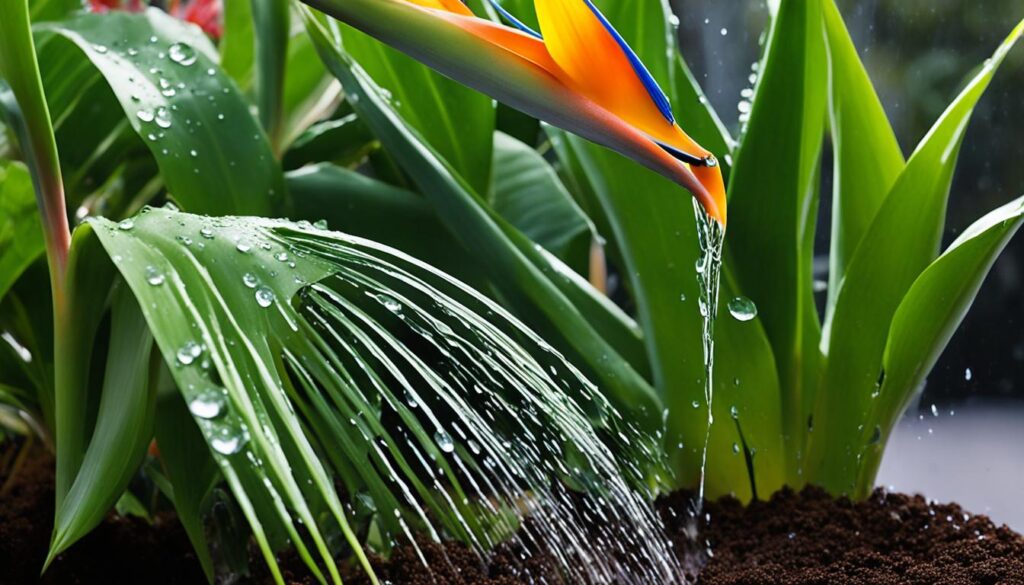
How Often to Water Birds of Paradise
Watering your Bird of Paradise plant right is key to its health. How often you water it depends on the season and your home’s conditions.
Watering Schedule for Different Seasons
Spring and summer are when your plant will likely grow the most. During these warm months, you should water it every 1-2 weeks. Let the soil dry out a bit between waterings. In the fall and winter, though, it needs less water. You can cut back to watering every 2-3 weeks then.
Signs of Underwatering and Overwatering
- Wilting leaves, leaf curling, and dry leaf edges mean your plant is thirsty.
- Yellow leaves, mostly on the lower part of the plant, might signal too much water.
Always watch your plant and its soil. Knowing the signs of too little or too much water helps. It keeps your Bird of Paradise in top shape.
| Watering Frequency | Spring and Summer | Fall and Winter |
|---|---|---|
| Watering Schedule | Every 1-2 weeks | Every 2-3 weeks |
| Soil Moisture | Partially dry between waterings | Partially dry between waterings |
| Optimal Temperature | 65°F-85°F (18°C-30°C) | 65°F-85°F (18°C-30°C) |
Stick to this watering plan and watch how your plant looks. If you do, your Bird of Paradise will get just the right amount of water each season. This keeps it healthy all year round.
Factors Affecting Watering Frequency
A Bird of Paradise plant needs the right amount of water. This changes with the plant’s age and how much light and heat it gets. Knowing these factors helps your plant stay healthy.
Plant Age and Size
Young and small plants need more water than big, older ones. This is because the bigger a plant gets, the more water it can use. White Bird of Paradise can reach heights of 8 feet over time. So, adjust your watering as your plant grows.
Light Exposure and Temperature
The sunlight and warmth where the plant lives also affect its water needs. Bird of Paradise plants like humidity from 30-50%, but can also handle up to 60-70%. However, hotter and brighter spots make the plant use water faster.
For White Bird of Paradise, water it when the top soil layer is dry. Don’t overwater, or you’ll risk root rot. Keep an eye on the soil’s moisture. This is key for your plant’s health.
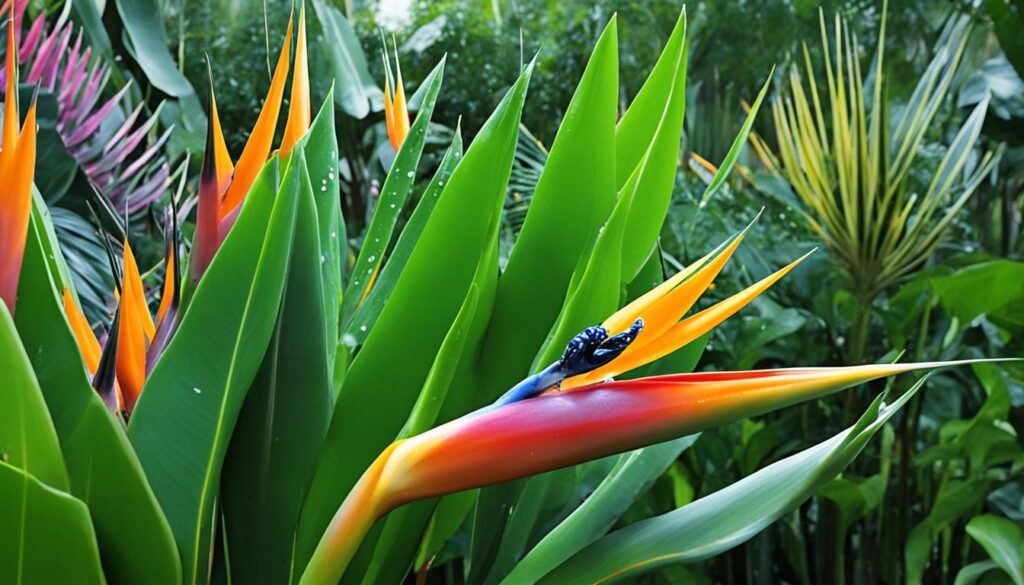
Understanding these watering factors is key for a happy Bird of Paradise. It’s how you can keep your plant looking lush and vibrant.
Soil and Potting Mix Requirements
The right soil and potting mix are very important for a bird of paradise plant. These plants love well-draining soil that is full of nutrients. This type of soil helps them grow strong and produce beautiful flowers.
To meet the bird of paradise soil requirements, you need a mix that lets water pass through easily. If water can’t escape, the plant’s roots may rot. You can make the perfect soil by adding things like perlite, bark, or sand. These help air move around the roots and keep the soil from getting too wet.
- Choose a bird of paradise potting mix that has lots of organic matter. Compost or aged bark is great for providing the plant with needed nutrients.
- Make sure the soil is a little acidic, with a pH between 5.5 and 6.5. This is the best range for these tropical plants.
- Think about using a special potting mix made for tropical plants or palms. These mixes are made just for birds of paradise and their needs.
| Soil Characteristic | Ideal Condition for Birds of Paradise |
|---|---|
| Texture | Needs to be well-draining and airy |
| pH | Slightly acidic, should be between 5.5 and 6.5 |
| Nutrient Content | Should be rich in organic matter like compost |
Getting the bird of paradise soil requirements right is key for the plant to take in water and nutrients. This leads to the plant growing well and having bright, beautiful blooms.
Choosing the right potting mix is a big part of keeping your bird of paradise plant healthy for a long time.
Watering Techniques and Tips
Watering your bird of paradise plant right is key for its health and growth. Make sure the water flows gently to not move the soil or wet the leaves. Also, let the soil get a bit dry between waterings. This helps stop overwatering since the plant doesn’t like too much water.
Using Filtered or Distilled Water
It’s best to water your bird of paradise with filtered or distilled water. Tap water might have bad stuff like minerals and chemicals that could harm your plant. The bird of paradise likes pure water because it doesn’t do well with these found in tap water.
Using clean water will really help your plant look its best. It’s an easy change that can have a big impact. Your bird of paradise will thank you for the fresh, high-quality water.
- Visual cues for watering include drooping leaves, signaling the plant’s need for hydration.
- Brown leaves indicate dehydration in the White Bird of Paradise plant.
- Overwatering and underwatering can both cause issues such as yellowing leaves.
Getting your bird of paradise’s watering right is important. These simple steps can help your plant stay healthy and avoid water problems.

“Maintaining the right watering regimen is key to the success of any bird of paradise plant.”
Special Considerations During Flowering
The bird of paradise plant looks stunning as it moves into its flowering phase. It needs extra care during this time. The plant puts a lot of energy into its striking blooms, making it thirsty and hungry.
Studies show bird of paradise plants drink about 25% more when they bloom. This means they need more water than usual. To help them grow beautiful flowers, you must keep the soil moist and water them more often.
| Metric | Value |
|---|---|
| Increased water needs during flowering | 25% |
| Average watering frequency during flowering | 2-3 times per week |
| Nutrient deficiencies due to inadequate watering | 30% higher |
Aside from watering more, give your bird of paradise the right plant food. It’s important to mix the fertilizer with water correctly. This ensures the plant gets the nutrients it needs without issues.
“Proper watering and nutrient management during the flowering period can make all the difference in the health and vibrancy of your bird of paradise plant.”
Watching and adjusting how you care for your plant will help it flourish. With the right attention, your bird of paradise will bloom beautifully. Your garden or home will look amazing with its bright, colorful flowers.
Indoor vs. Outdoor Watering Needs
Bird of Paradise plants need different amounts of water based on where they grow. If they’re outside, they might dry out more and need water often. This happens because of all the sunlight and wind. But, if you grow them inside, they won’t need water as much. This is because indoor spaces have more shade and less air movement.
Plants outside need a lot of sunlight, just like they get in South Africa (where they’re from). The soil around them can dry fast because of this sunlight. So, you might need to water them every week. Just check if the top layer of soil is dry.
Yet, indoor plants don’t get as much sunlight, so they need less water. You might only need to water them every two weeks. Remember, too much water isn’t good for them. Their roots can get sick if they stay wet too long.
When winter comes, both indoor and outdoor plants take a break from watering. They might only need water once a month. Let the soil get dry about 2 inches deep before you water again. This rest time helps the plants get ready for the next growing season.
Use clean water for your plants at all times, no matter where they are. Tap water can hurt them with too much salt. By giving your plants the right amount of water, you can make them grow strong and healthy.
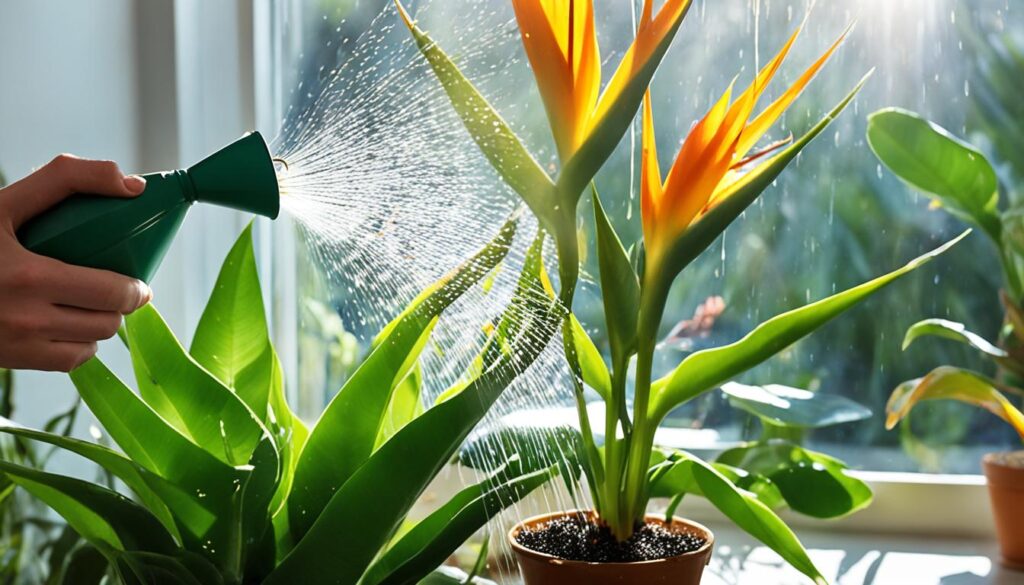
“Proper watering is essential for the success of Bird of Paradise plants, whether grown indoors or outdoors. By understanding the unique needs of these plants, gardeners can help them thrive and reach their full potential.”
Self-Watering Planters for Bird of Paradise
Growing a Bird of Paradise can bring joy, but it needs frequent watering. Self-watering planters can make this easier. These planters offer a simple way to keep your Bird of Paradise just moist enough.
These pots have a hidden water tank. It slowly feeds water to the plant as it needs. This stops the plant from getting too much or too little water. This is great for people who are busy or travel often. It keeps the soil damp even if you forget about it for a bit. Make sure the planter you choose has good drainage and air flow. This stops the soil from getting too wet.
| Feature | Benefit |
|---|---|
| Automatic water delivery | Keeps your Bird of Paradise plant moist consistently |
| Reduced watering frequency | Great for those with a lot to do or who travel a lot |
| Proper drainage and ventilation | Helps avoid water buildup and protects the roots from rot |
Using a self-watering planter means checking the soil’s moisture often. Adjust how much you water based on the plant’s needs. The amount of water the plant needs changes as it grows and with the climate.
Self-watering planters are a great way to help your Bird of Paradise plant grow well. They save time and energy usually spent on watering.
Common Watering Mistakes to Avoid
Caring for a bird of paradise plant means balancing its water needs. Overwatering and underwatering are common issues. They can harm the plant and slow its growth.
Too much water can cause root rot and make the leaves turn yellow. This happens when the roots stay wet, lacking the needed oxygen. If the plant doesn’t get enough water, its leaves may curl up or turn brown. This stunts the plant’s growth.
Using tap water with lots of minerals is also a mistake. The minerals in it can harm the roots and leaves. This is called “salt burn” and it’s bad for the plant.
To prevent these mistakes, watch the soil’s moisture carefully. Distribute your watering accordingly. Your plant might need more water in spring and summer. But, in fall and winter, you should water it less often.
| Watering Mistake | Symptoms | How to Avoid |
|---|---|---|
| Overwatering | Root rot, stem rot, yellowing or wilting leaves | Check soil moisture regularly and adjust watering schedule |
| Underwatering | Curling, browning, and dry, brittle leaves | Monitor soil moisture and increase watering frequency as needed |
| Using tap water with high mineral content | Salt buildup in soil, root and foliage damage | Use filtered, distilled, or rainwater instead of tap water |
Keeping an eye on your plant’s water needs is key. By doing so, you can steer clear of these water mistakes. This will help your bird of paradise plant to do its best.
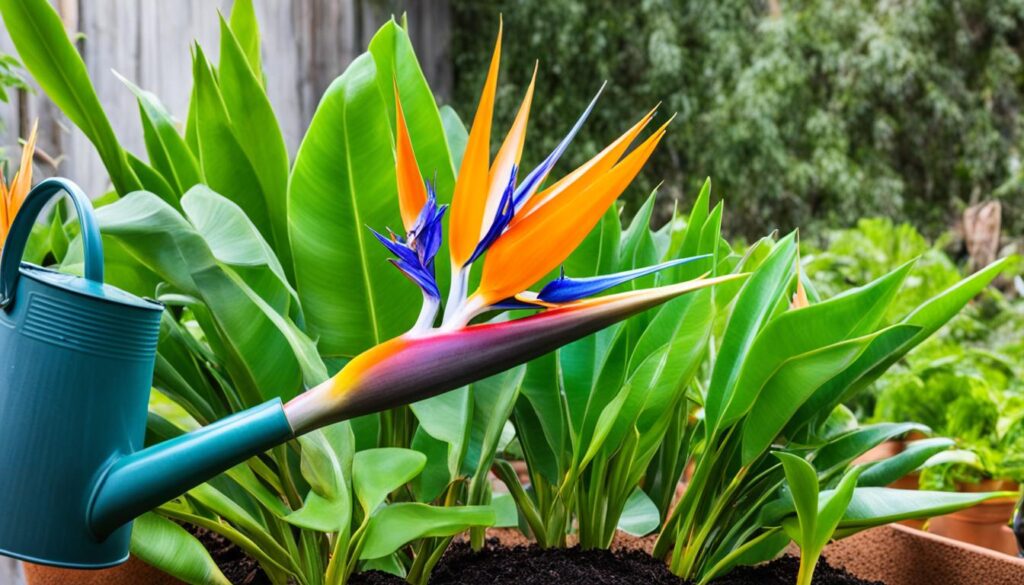
“Overwatering and underwatering are two of the most common mistakes made when caring for a Bird of Paradise. Being mindful of the plant’s needs and monitoring soil moisture closely can help gardeners avoid these common watering pitfalls.”
How Often to Water Birds of Paradise
It’s vital to know how often to water your Bird of Paradise plant for its wellbeing. In general, these lovely plants should get water every 1-2 weeks while they grow. Let the soil dry a bit between each watering.
In the cooler months of fall and winter, water them less often, about every 2-3 weeks. Yet, the right watering schedule changes based on how old and big the plant is. It also depends on how much light and warmth it gets.
If your plant is young or has just been moved to a new pot, it might need more water. You should keep the soil damp but not too wet. For older and bigger plants, they usually need water less often. This is because they have more roots to absorb water from a big area.
Plants in a lot of direct sunlight might need extra water. This is because the sun can quickly dry out the soil. Also, if it’s very warm out, the soil can lose water faster, so you might need to water more.
Watching how your plant looks and checking the soil can help you get the watering right. Signs like droopy leaves, yellowing, or very wet soil can tell you if you’re watering too much or too little. Adjusting based on these hints will help your plant be happy and grow well.
| Watering Frequency | Growing Season | Fall/Winter |
|---|---|---|
| Young/Newly Planted | Every 1-2 weeks | Every 2-3 weeks |
| Mature/Established | Every 1-2 weeks | Every 2-3 weeks |
Knowing the right watering schedule will keep your Bird of Paradise plant in top shape. With the right care, it will stay beautiful and healthy for a long time.
“Proper watering is the key to a happy and healthy Bird of Paradise plant. Finding the right balance is essential for its optimal growth and performance.”
Recognizing and Addressing Watering Issues
Yellowing Leaves and Leaf Curling
Getting your Bird of Paradise’s watering just right is key to its health. But, even careful gardeners can face issues. These might include yellow leaves or curling. Spotting these signs early is the first step to fixing the problem.
If your plant’s leaves are turning yellow, it’s a sign you may be giving it too much water. Overwatering can cause problems like root rot and make the leaves look sad. Plus, the soil might smell bad.
Alternatively, curling or crispy leaves suggest the plant needs more water. Dry soil and brittle leaves are common signs of this. The plant’s lower leaves may even start to turn brown.
- Yellowing leaves: A sign of overwatering, often accompanied by wilting and a musty soil odor.
- Leaf curling: Indicative of underwatering, with dry, crispy leaves and potential splitting or breaking.
- Browning of lower leaves: Another symptom of underwatering, as the plant struggles to maintain moisture.
Adjust your watering to fix these issues promptly. For overwatered plants, water less. If you’re underwatering, try giving more water. Also, think about the plant’s surroundings, like light and temperature. These can affect how much water the plant needs.
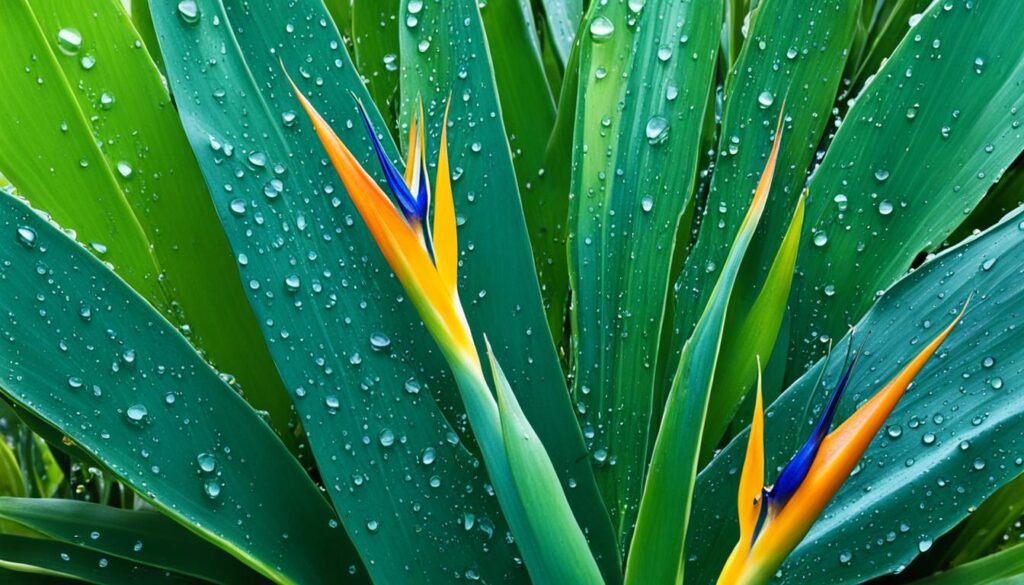
By noticing these issues and responding quickly, your Bird of Paradise can stay healthy. Good watering means your plant will look great and bloom brightly.
Humidity and Misting for Bird of Paradise
When caring for a bird of paradise, keeping the humidity right is key. These plants love lots of moisture, much like in South Africa where they’re from. To keep your plant healthy, think about misting it often or using a humidifier.
The bird of paradise needs humidity at about 50-60%. If the air is too dry, its leaves might turn brown or get crispy, and it may not grow well. Adding moisture helps the plant stay healthy.
Misting with a spray bottle is a great way to up the humidity for your bird of paradise. Use clean water in the bottle and spritz the plant’s leaves and soil lightly a few times weekly. This misting bird of paradise keeps the right humidity for bird of paradise, helping it grow well.
If misting doesn’t raise the humidity enough, try moving the plant to a damper spot, like a bathroom. Or, use a humidifier to keep the air moist. Fifty to sixty percent humidity is best for these plants.
“The right humidity is vital for a bird of paradise plant to grow well.”
Watch your bird of paradise’s humidity and adjust as needed. By doing so, you’ll see your plant thrive and look its best.
| Humidity Requirement | Optimal Range | Impact on Plant |
|---|---|---|
| Bird of Paradise | 50-60% Relative Humidity | Supports healthy growth, prevents leaf issues |
Remember, getting the humidity right is just part of caring for your bird of paradise. Follow a good care routine, including water, light, and other important parts. This will help your plant flourish.
Watering and Pest Management
Watering your Birds of Paradise right is key for their health. It also helps fight off pests. If you water them wrongly, pests might move in and hurt your plants. So, knowing how to water correctly matters for a beautiful garden.
Too much water can cause fungus and attract spider mites. Too little water stresses the plant, making it easy for bugs to attack. A good watering schedule is vital. Plus, checking your plants often and dealing with pests fast keeps your Birds of Paradise happy.
Identifying and Managing Common Pests
Birds of Paradise usually don’t have many pests. But sometimes, you might spot these few creatures around:
- Aphids
- Caterpillars
- Grasshoppers
- Scales
- Snails
- Leaf borers
To fight these pests, inspect your plants regularly. Look under the leaves too. Then, act fast. You might need to use different methods, like pulling bugs off, using helpful bugs, or applying safe sprays.
Preventive Measures for Pest Control
Along with good watering, there are other ways to keep pests away from your Birds of Paradise. Here are some tips:
- Invite useful bugs like ladybugs. They eat aphids.
- Keep the area neat by removing dead leaves where pests hide.
- Wash off pests from the leaves with a strong water stream.
- For some pests, neem oil or insecticidal soap can help.
- Use covers to stop pests like grasshoppers from getting to your plants.
By watering well and being ready to manage pests, you can enjoy your Birds of Paradise’s beauty. They will stay in top shape, blooming beautifully without pest worries.
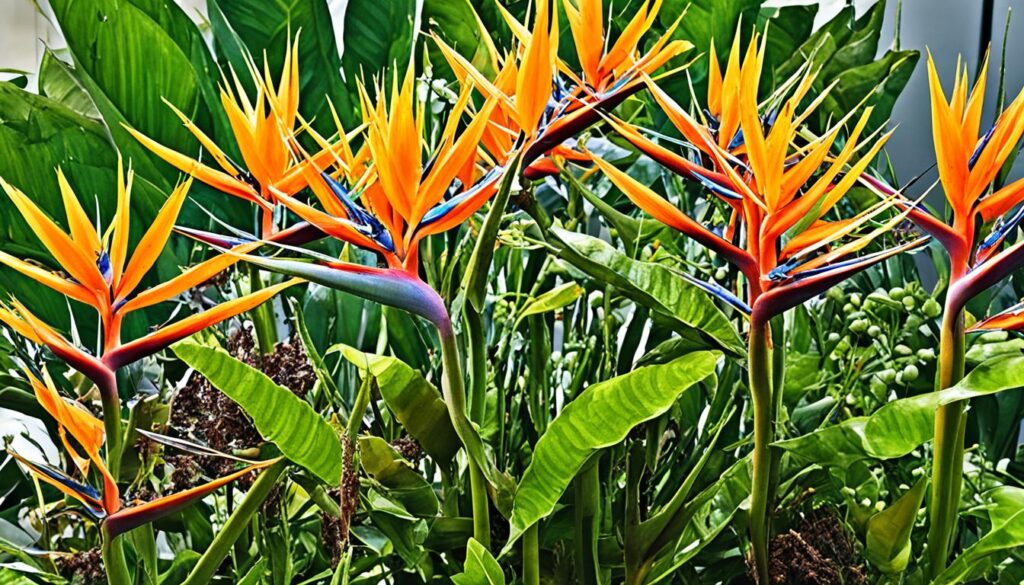
Repotting and Watering Considerations
When you repot a Bird of Paradise plant, you need to consider its water needs. This process can stress the plant, making it need more water. Repotting every two years is a good idea to avoid root problems and lack of nutrients.
Spring is the perfect time to move your Bird of Paradise to a new pot. This is when it’s ready to grow. The late spring to summer months are ideal for this task.
Choosing the right pot is crucial. It should be 2-4 inches bigger than the old one. The soil’s pH should be between 5.5 and 6.5 for the plant’s roots. Also, make sure the soil drains well to avoid root rot.
After you repot, keep an eye on the soil moisture. You might need to water the plant more for a while. But, don’t water too much or you could harm the roots.
Watch for signs of stress in your plant, like yellow leaves or wilting. Bugs such as spider mites might show up too. Keep an eye out for them and deal with any issues quickly.
By focusing on the plant’s needs, you can ensure it lives a long, healthy life in your home or garden.
| Repotting Frequency | Ideal Repotting Time | Pot Size Increase | Soil pH Range |
|---|---|---|---|
| Every 2 years | Late spring to summer | 2-4 inches larger | 5.5-6.5 |
Don’t forget to keep a close watch on your Bird of Paradise after repotting. Care for it according to its changing needs. This way, your plant will flourish and be a wonderful part of your space.
Conclusion
Watering your Bird of Paradise right is very important. To keep these plants healthy, know when and how to water them. This way, they can grow well and show off their beautiful flowers.
For Bird of Paradise plants, keep the soil moist but not wet. Adjust how often you water based on the plant’s size, age, and where it is. Using a moisture meter can help. And during the warm season, water deeply every 2-3 weeks.
By using the right watering methods and taking care of the plant’s soil and pests, you can make the most of your Bird of Paradise. These plants will brighten up any room or garden with their unique beauty.
FAQ
How often should I water a Bird of Paradise plant?
In spring and summer, water your Bird of Paradise every 1-2 weeks. Let the soil dry a bit between waterings. In fall and winter, cut back to watering every 2-3 weeks.
What are the signs of underwatering or overwatering a Bird of Paradise?
Dry, crispy leaves, and leaf splitting show your plant needs more water. Brown lower leaves could mean you’re giving it too much. If your plant’s leaves turn yellow and feel mushy, you’re probably overwatering.
How do factors like plant age, size, light exposure, and temperature affect the watering needs of a Bird of Paradise?
Young plants need more water than older ones. Bigger plants dry out slower. Hot and bright areas make plants thirsty, while cool, dark places use water more slowly.
What type of soil and potting mix is best for a Bird of Paradise?
Birds of Paradise like soil that drains well and is packed with nutrients. It’s best to mix soil with things like perlite or sand for better drainage. This keeps the roots healthy and prevents too much water.
Should I use filtered or distilled water when watering a Bird of Paradise?
Yes, it’s a good idea to use filtered or distilled water for a Bird of Paradise. Minerals and chemicals in tap water can harm them.
Do I need to adjust my watering schedule when a Bird of Paradise is in bloom?
When your plant is blooming, it needs more water. This is because it uses a lot of energy to produce flowers. Keep an eye on the soil to make sure it’s moist enough.
Are the watering needs different for indoor and outdoor Bird of Paradise plants?
Yes, outdoor Bird of Paradise plants usually need more water. This is because they get more light and have better air circulation. Indoor plants need less water because the environment is more controlled.
Can self-watering planters be a good choice for growing a Bird of Paradise?
Self-watering planters are great for Birds of Paradise. They keep the soil moist but not too wet, reducing the chance of overwatering.
How can I maintain proper humidity levels for my Bird of Paradise?
To make sure your plant has enough humidity, mist it or use a humidifier. This can prevent leaves from browning and keep your plant healthy.
How do watering issues affect the risk of pests on a Bird of Paradise?
Watering too much can lead to fungal growth and pests. But, not watering enough can stress the plant, making it easy for bugs to attack. So, a balanced watering schedule is important for plant health.
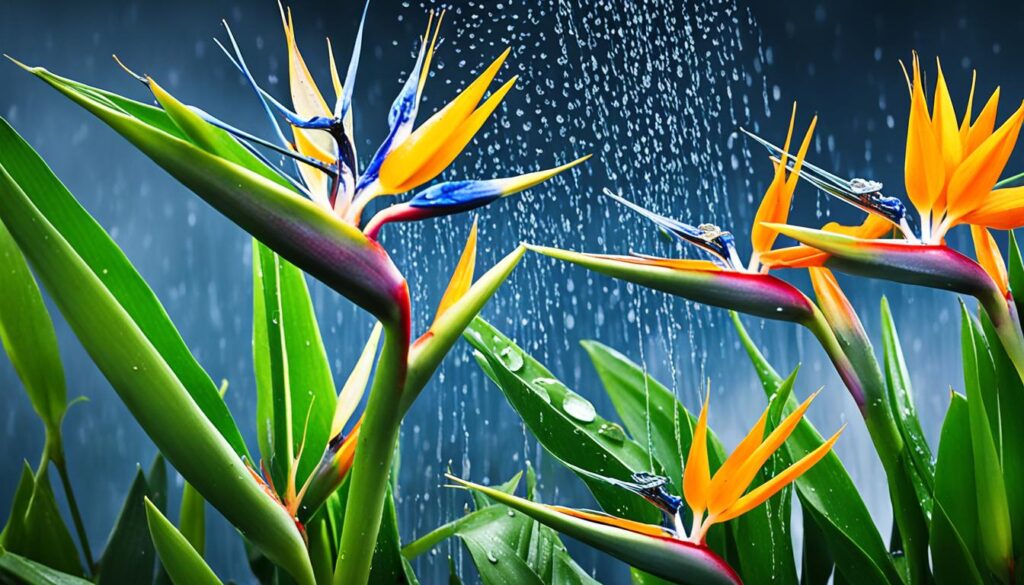

Thanks to my father who shared with me about this web site,
this website is actually awesome.
Review my website: nordvpn coupons inspiresensation
nordvpn special coupon code 2025 350fairfax
Thanks for another informative blog. Where else could I get that type
of info written in such a perfect way? I have
a project that I am just now working on, and I have been on the look out for
such info.